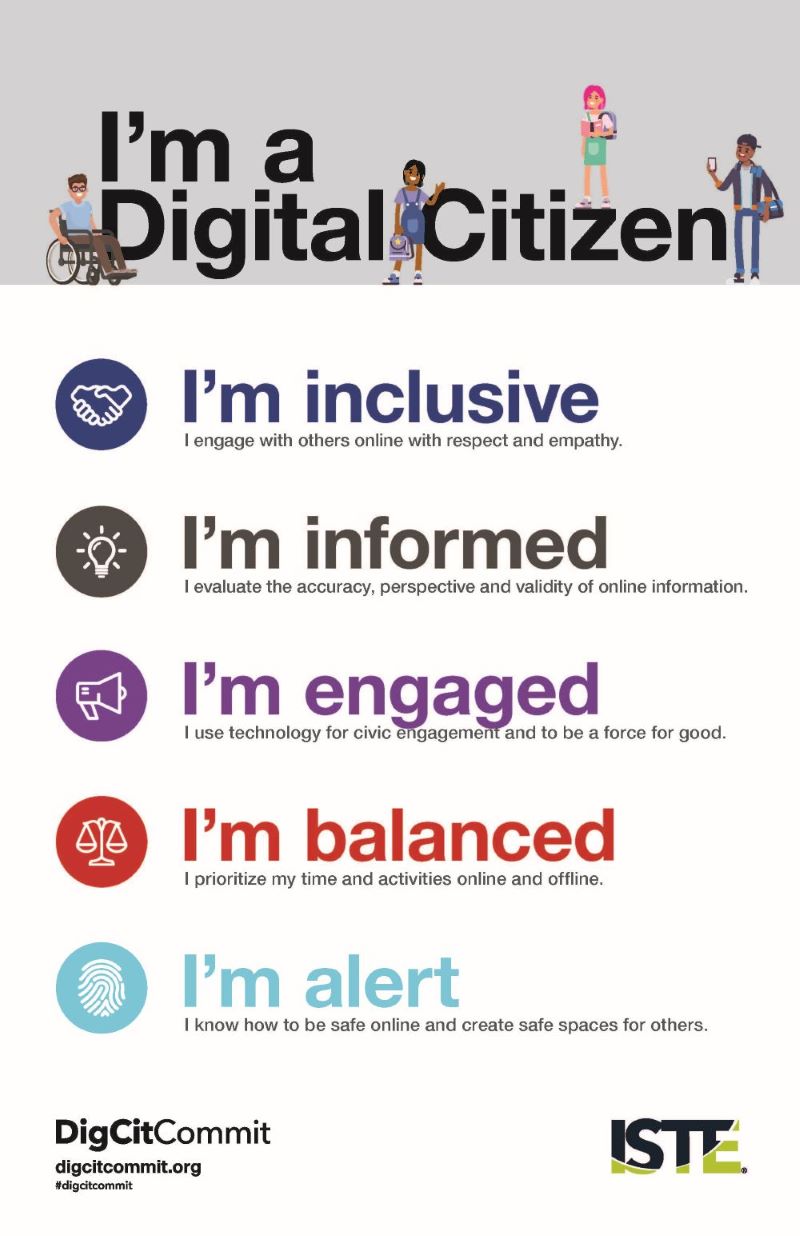Digital Citizenship.

What is it? Is it important? How do we teach it?
Those are questions that are often asked by teachers and administrators who are unaware of the topic or don’t see the value in it. So let’s start by breaking it down.
According to dictionary.com, a digital citizen is “a person who develops the skills and knowledge to effectively use the Internet and other digital technology, especially in order to participate responsibly in social and civic activities.”
There is some truth to this, but there has to be more to it.
If we want to truly understand what it means to be a digital citizen, we need to understand citizenship. Being a good citizen goes even further than being a responsible member of our world. Being a positive citizen means living with purpose and giving back to the world we live in. So just as we intend to teach our students how to be active, contributing, and caring citizens in our world, the same goes for the online world. It’s important to note that “digital citizenship requires the same integrity, respect and care for others as real world citizenship”, as Andrew Kovalcin says.

As teachers, it’s our responsibility to authentically integrate digital citizenship into the curriculum in a positive way. It’s about developing active and caring citizens in our classrooms who want to make change online. Trevor makes a good point when he says that “students must be taught that the digital world is actually the real world, there is no difference. Therefore, their actions, behaviours, and words online should resemble the person they are when not using technology.”
Along with integrating positive citizenship into our classrooms, we need to develop critical thinkers as well. The article, “How Finland Starts its Fight Against Fake News in Primary Schools”, talks about the success that Finland has had when teaching students the skills of “thinking critically, fact-checking, interpreting and evaluating all the information you receive.” They focus on integrating these skills among every subject area so that it becomes second nature to them. It’s important to recognize that even though students might seem tech-savvy, or are looked at as “digital natives”, they still need to be taught these critical thinking skills because these characteristics are developed over time, and are not automatic.
So how do we, as educators, teach our students to be digital citizens? First of all, we need to remember that “digital citizenship education is not intended to be a stand-alone unit, course or lesson, rather it is best learned and under- stood when taught in context through supported online practice and real-life examples and experiences”, according to Saskatchewan’s Digital Citizenship Policy Planning Guide.
When it comes to teaching our students to be thriving digital citizens, ISTE says that it is more about the “do’s” rather than the “don’ts”. They say “it’s about being active citizens who see possibilities instead of problems and opportunities instead of risks as they curate a positive and effective digital footprint.” They also come up with a list of attributes that make up a positive digital citizen.
ISTE’s 5 Competencies of Digital Citizenship is a list that every teacher can focus on when raising digital citizens in their classrooms.
Along with teaching students the 5 Competencies of a Digital Citizen, it’s important that we encourage our students to be motivated citizens online. In a previous blog post, I talk about the importance of raising digital leaders in a digital age who feel empowered to use tools online for good. I bring up a quote by George Couros who says that students need to learn how to be digital leaders who use “the vast reach of technology (especially the use of social media) to improve the lives, well-being, and circumstances of others.”
As we progress in a digital age, we as educators need to progress in our practices. We need to be aware of the value and importance of raising online citizens who are critical thinkers and world changers…
…because after all “educators can no longer ignore their roles in helping students to develop as digital citizens; schools must respond to the changing needs of our learners in order to prepare them for our rapidly changing world” (Saskatchewan’s Digital Citizenship Policy Planning Guide).
As I say in the video I created about what it means to be a (digital) citizen:
While it’s important that a digital citizen knows how to be safe and responsible online, we need to remember that we can’t stop there. Let’s encourage digital citizens who want to lead and inspire.
I am a (digital) citizen. Are you?





Great post! Thank you for sharing great resources and information on being a good digital citizen. I believe you teach primary. I’d love to hear how you implement this in your teaching. I have been trying out resources and having great conversations with my grade2/3’s. How do you teach being digital citizenship, identity and media literacy to your students?
Christina 🙂
LikeLike
Thanks for reading, Christina! I try to incorporate these topics in authentic ways throughout the year, but at the beginning of the school year, I explicitly teach terms and ideas surrounding the topic of Digital Citizenship because they are still little and some have never learned about it yet. As we progress through the year, I integrate it into our literacy times and throughout other subjects. I love using the website Digital Read Works. It’s kind of like Raz Kids because you can track students, but it focuses on non-fiction articles. It allows students to use critical thinking skills and media literacy skills in a safe environment at their own reading level. These are just a few ways, but if you want to learn more, I would love to share! Thanks again for taking the time to read it 🙂
LikeLiked by 1 person
Great post! I especially loved your quote: “As teachers, it’s our responsibility to authentically integrate digital citizenship into the curriculum in a positive way. It’s about developing active and caring citizens in our classrooms who want to make change online.” The idea that it is authentically integrated into curriculum makes it much stronger and creates a much more powerful impact on students and their learning. It’s about raising good humans, on and offline. I think you do a wonderful job of explaining the importance and urgency of taking this seriously as educators! Thanks for sharing!
LikeLiked by 1 person
Thanks for reading, Shelby! I’m glad that you were able to take away a few points from the post.
LikeLiked by 1 person